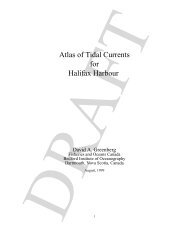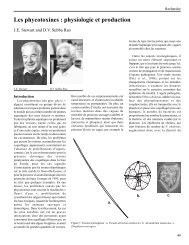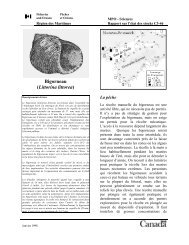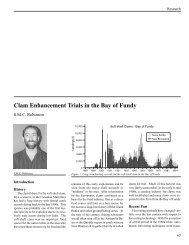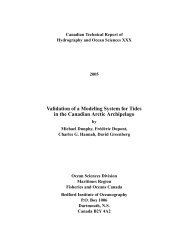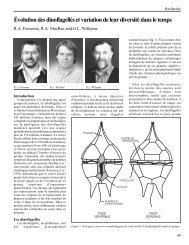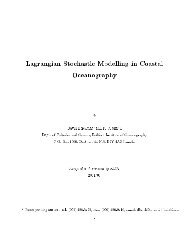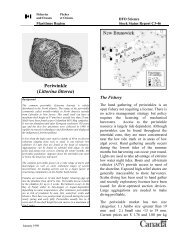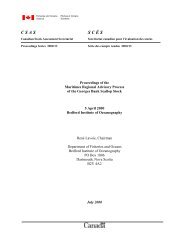bedford institute of oceanography 2001 in review - Région des ...
bedford institute of oceanography 2001 in review - Région des ...
bedford institute of oceanography 2001 in review - Région des ...
Create successful ePaper yourself
Turn your PDF publications into a flip-book with our unique Google optimized e-Paper software.
SCIENCE ACTIVITIES / Biological SciencesStock assessments, research, and outreachIn addition to rear<strong>in</strong>g fish, the Mactaquac Biodiversity Facility yieldsbiological <strong>in</strong>formation. In particular, its trapp<strong>in</strong>g facility at theMactaquac Dam yields important <strong>in</strong>formation for the assessment <strong>of</strong>salmon, alewife, blueback herr<strong>in</strong>g, American eel, striped bass, andAtlantic and shortnose sturgeon. Research is also conducted <strong>in</strong> cooperationwith universities, private <strong>in</strong>dustry, and fish and wildlifeorganizations. Investigations have <strong>in</strong>cluded the viability <strong>of</strong> triploidsalmonids for aquaculture, vacc<strong>in</strong>e development, and growth andcondition <strong>of</strong> fish reared at various temperature regimes. Cooperativeprograms with local First Nations contribute to the facility’s operations,<strong>in</strong>clud<strong>in</strong>g a Visitor Interpretation Center. The Visitor Centerexhibits the operations <strong>of</strong> the facilities and the life cycle <strong>of</strong> theAtlantic salmon.Coldbrook and Mersey Biodiversity facilitiesThe Coldbrook and Mersey Biodiversity facilities engage <strong>in</strong> live genebank<strong>in</strong>g <strong>of</strong> Atlantic salmon, stock<strong>in</strong>g <strong>of</strong> salmon <strong>in</strong> rivers negativelyimpacted by acid precipitation, and research on a variety <strong>of</strong> salmonand endangered Atlantic whitefish <strong>in</strong>itiatives. These activities replaceprevious enhancement programs.Liv<strong>in</strong>g gene banksAs was the case at Mactaquac <strong>in</strong> 1998, a few <strong>of</strong> the many ponds atColdbrook were dedicated to the first phase <strong>of</strong> live gene bank<strong>in</strong>gthe endangered Nova Scotia <strong>in</strong>ner Bay <strong>of</strong> Fundy salmon. In thiscase, wild juvenile salmon from the Stewiacke River are be<strong>in</strong>greared through to maturity at Coldbrook. Between 0.5 and 1.0million eggs will be hatched and grown at Mersey for release <strong>in</strong>tothe Stewiacke and other <strong>in</strong>ner Bay <strong>of</strong> Fundy rivers, from whichsalmon have been extirpated. Implicit <strong>in</strong> our direction for theliv<strong>in</strong>g gene banks is a DNA-based prescriptive mat<strong>in</strong>g strategy likethat <strong>des</strong>cribed for Mactaquac.Additionally, progeny <strong>of</strong> adult salmon <strong>of</strong> the <strong>in</strong>ner Bay <strong>of</strong> Fundy’sunique Gaspereau River are reared and returned to the river. Juvenilesfrom several other Nova Scotia <strong>in</strong>ner Bay <strong>of</strong> Fundy rivers have beencollected for possible <strong>in</strong>clusion <strong>in</strong> the <strong>in</strong>ner Bay gene bank program.Intervention <strong>in</strong> acid-impacted riversAcid precipitation has contributed to serious decl<strong>in</strong>es, and <strong>in</strong> somecases, extirpation, <strong>of</strong> salmon <strong>in</strong> over 50 rivers <strong>of</strong> the Nova ScotiaSouthern Upland. Adult salmon are be<strong>in</strong>g collected from severalrivers to supplement smolt production due to losses caused by acidprecipitation. Genetic analysis <strong>of</strong> many other river stocks is ongo<strong>in</strong>gand <strong>in</strong> the short term, supplementation with cultured fish and orlive gene bank<strong>in</strong>g should avoid complete loss <strong>of</strong> the unique stocks.Research, First Nations support, and outreachBreed<strong>in</strong>g, rear<strong>in</strong>g, and stock<strong>in</strong>g fish <strong>in</strong> support <strong>of</strong> fisheries was theprevious pr<strong>in</strong>cipal activity <strong>of</strong> federal fish hatcheries <strong>in</strong> Nova Scotia.Few fisheries now rema<strong>in</strong> and the preservation <strong>of</strong> stocks and theirgenetic diversity is becom<strong>in</strong>g the goal.Conf<strong>in</strong>ed to a s<strong>in</strong>gle watershed <strong>in</strong> Nova Scotia, the endangeredAtlantic whitefish (Coregonus huntsmani) is be<strong>in</strong>g cultured at Merseyto ascerta<strong>in</strong> the <strong>in</strong>fluence <strong>of</strong> environmental variables on its survivaland growth. Ultimately, the goal is to develop technical capability torepatriate the species to its former range.Mersey Biodiversity Facility upper ponds and culture and research build<strong>in</strong>gs.The Mersey and Coldbrook Biodiversity facilities are operatedjo<strong>in</strong>tly to meet program objectives. The brood fish for all salmonprograms are held at Coldbrook, where surface and well waterprovide temperature control and flexibility. Rear<strong>in</strong>g <strong>of</strong> young takesplace at Mersey where the greater water supply permits the production<strong>of</strong> up to 300,000 age-1 sea-go<strong>in</strong>g smolts, and an equal or greaternumber <strong>of</strong> age-0 parr for river stock<strong>in</strong>g.Endangered Atlantic whitefish, Coregonus huntsmani.The facilities also support salmon conservation <strong>in</strong>itiatives identifiedby First Nations, welcome tour groups, and <strong>of</strong>fer tra<strong>in</strong><strong>in</strong>g forcommunity college students.32 / BIO-<strong>2001</strong> IN REVIEW



